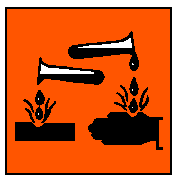International Chemical Safety Cards
| 3-DIMETHYLAMINOPROPYLAMINE | ICSC: 1227 |
| 3-DIMETHYLAMINOPROPYLAMINE 1-Amino-3-dimethylaminopropane N,N,-Dimethyl-1,3-propanediamine 3-Aminopropyldimethylamine N,N-Dimethyl-1,3-diaminopropane C5H14N2/(CH3)2NCH2CH2CH2NH2) Molecular mass: 102.2 CAS # 109-55-7 RTECS # TX7525000 ICSC # 1227 UN # 2734 EC # 612-061-00-6 |
 |
| TYPES OF HAZARD/ EXPOSURE |
ACUTE HAZARDS/ SYMPTOMS |
PREVENTION | FIRST AID/ FIRE FIGHTING |
| FIRE | Flammable. Gives off
irritating or toxic fumes (or gases) in a fire. |
NO open flames, NO sparks,
and NO smoking. |
Powder, alcohol-resistant
foam, water spray, carbon dioxide. |
| EXPLOSION | Above 35°C explosive
vapour/air mixtures may be formed. |
Above 35°C use a closed
system, ventilation, and explosion-proof electrical equipment. |
In case of fire: keep
drums, etc., cool by spraying with water. |
| EXPOSURE | |
AVOID ALL CONTACT! |
|
| INHALATION | Burning sensation. Cough.
Wheezing. |
Ventilation, local exhaust,
or breathing protection. |
Fresh air, rest. Refer for
medical attention. |
| SKIN | Pain. Blisters. |
Protective gloves.
Protective clothing. |
Remove contaminated
clothes. Rinse skin with plenty of water or shower. Refer for medical attention. |
| EYES | Pain. Blurred vision.
Severe deep burns. |
Face shield, or eye
protection in combination with breathing protection. |
First rinse with plenty of
water for several minutes (remove contact lenses if easily possible), then take to a
doctor. |
| INGESTION | Abdominal cramps. Burning
sensation. Shock or collapse. |
Do not eat, drink, or smoke
during work. |
Rinse mouth. Do NOT induce
vomiting. Refer for medical attention. |
| SPILLAGE DISPOSAL | STORAGE | PACKAGING & LABELLING | ||
| Ventilation. Collect leaking
and spilled liquid in sealable containers as far as possible. Wash away remainder with
plenty of water (extra personal protection: self-contained breathing apparatus). |
Fireproof. Separated from
strong oxidants, strong acids, food and feedstuffs. Dry. Well closed. |
Do not transport with food
and feedstuffs. C symbol R: 10-22-34-43 S: (1/2-)26-36/37/39-45 UN Hazard Class: 8 UN Subsidiary Risks: 3 |
||
| SEE IMPORTANT INFORMATION ON BACK | ||||
|
||||